 |

Special Effects and CGI
The 3 minutes and 25 seconds of animation Corbitt Design produced for the movie were created by seasoned special effects supervisor Pat Corbitt and the amazingly talented designer and modeler Dan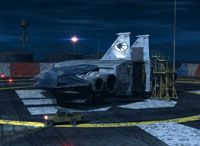 Dipierro. All the scenes you see in the stills and movies on this page were created entirely in Lightwave 3D Vsn 5.0, except for the use of the two noted photographs. Other than two background photographs, every element is synthetic. Throughout this page, Dan and Pat share some of the challenges they faced and reveal behind-the-scenes tidbits. Dipierro. All the scenes you see in the stills and movies on this page were created entirely in Lightwave 3D Vsn 5.0, except for the use of the two noted photographs. Other than two background photographs, every element is synthetic. Throughout this page, Dan and Pat share some of the challenges they faced and reveal behind-the-scenes tidbits.
"The main ship in the film, the Armstrong (seen at right), is supposed to look like it was designed by NASA," Dan reveals. "Sort of a next-generation space shuttle that's seen better days. Thus, the production designer created a front that was very sculpted and sleek, reminiscent of the current Space Shuttle. The back has a hole cut out in the middle for carrying large cargo containers which get docked in there. The Armstrong is meant to be mainly a cargo ship but is equipped with enough compartments for a handful of passengers. The shape of the ship looks the way it does because it is a lifting body, which means that lift is generated from the wings and from the overall shape of the body."
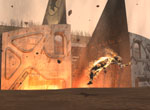 One of Pat and Dan's favorite scenes is where a (not-so-nice) character named Lazarus gets fried by the ship's engines. "This scene wasn't in the shooting script," Dan remembers. Pat adds, "The producers were great about giving us creative freedom and bouncing ideas around. The seasoned film professionals at 360 respected our expertise in the special effects area and we respected theirs in the live action and moviemaking realms. That reciprocal relationship led to the development of scenes like this one which weren't in the shooting script." Dan continues, "We had to finish off Lazarus and we wanted to show the power of the Armstrong's vertical thrusters. We mocked up the shot as a still frame and it was so powerful that the producers commissioned an extra scene that allowed us to set a model of a human body model on fire and catapult it out of the frame. Something they never could have shot, of course!" We've included a half-size movie of Lazarus meeting his end for you to see how the scene plays out (633K). One of Pat and Dan's favorite scenes is where a (not-so-nice) character named Lazarus gets fried by the ship's engines. "This scene wasn't in the shooting script," Dan remembers. Pat adds, "The producers were great about giving us creative freedom and bouncing ideas around. The seasoned film professionals at 360 respected our expertise in the special effects area and we respected theirs in the live action and moviemaking realms. That reciprocal relationship led to the development of scenes like this one which weren't in the shooting script." Dan continues, "We had to finish off Lazarus and we wanted to show the power of the Armstrong's vertical thrusters. We mocked up the shot as a still frame and it was so powerful that the producers commissioned an extra scene that allowed us to set a model of a human body model on fire and catapult it out of the frame. Something they never could have shot, of course!" We've included a half-size movie of Lazarus meeting his end for you to see how the scene plays out (633K).
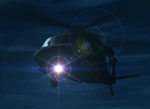 "This is Blackhawk helicopter. Originally, we were going to use a Cobra, which I already had modeled," says Dan. "But we decided to go with the Blackhawk to give it a more modern feel. I modeled the Blackhawk by hand in about three days to use in the opening scene where we see a load of biohazardous material being buried in the desert." "This is Blackhawk helicopter. Originally, we were going to use a Cobra, which I already had modeled," says Dan. "But we decided to go with the Blackhawk to give it a more modern feel. I modeled the Blackhawk by hand in about three days to use in the opening scene where we see a load of biohazardous material being buried in the desert."
"The producers got the idea for this shot from a test we'd sent them a few months before. I'd gone out in my backyard and shot some video, then modeled a Cobra and composited over the live action. Doing it all in 3-D was a lot cheaper than renting a Blackhawk."
 "Unlike the helicopter, the trucks were an original design," recalls Dan, "I sketched them from a couple different views, then I went straight to the modeler. I wanted them to be massive and have very large tires for the desert terrain. They are so big, you could probably fit twenty guys in the cargo area. If you look closely, you can probably tell who it's made by. "Unlike the helicopter, the trucks were an original design," recalls Dan, "I sketched them from a couple different views, then I went straight to the modeler. I wanted them to be massive and have very large tires for the desert terrain. They are so big, you could probably fit twenty guys in the cargo area. If you look closely, you can probably tell who it's made by.
"My many many years shooting television really show in how we set up and choreograph the moves," Pat maintains. "The use of the camera is critical here. We think like film directors, using tracking shots or quick moves to accentuate certain parts of the action and give it a corresponding feel."
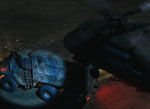 "The key to making this scene look real is in the detail," Dan reports. "It's really things like the tire that make you feel like it was actually filmed on location. They have treads and are caked with a dusty material. The basic look we went for in every scene was to make them look photorealistic by piling on the textures. The key is to have an eye for what makes things look real-- the dust, the chipping paint, the color of the lights. In the film, you can see the spotlight track over the truck--the bluish tone is really eerie and lifelike." "The key to making this scene look real is in the detail," Dan reports. "It's really things like the tire that make you feel like it was actually filmed on location. They have treads and are caked with a dusty material. The basic look we went for in every scene was to make them look photorealistic by piling on the textures. The key is to have an eye for what makes things look real-- the dust, the chipping paint, the color of the lights. In the film, you can see the spotlight track over the truck--the bluish tone is really eerie and lifelike."
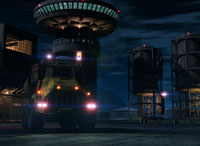 "This is the shuttle launch site environment. It's packed full of models, all of which I built as futuristic, but run down and worn by time and weather. This scene establishes where the Armstrong is from and that it's really a surplus, second-hand craft. To support this, I put a lot of detailing into the 'background elements,' like the framework on the tanks and the lights inside the control tower. If you look closely at the picture at the top of this page, the scaffolding at the back of the Armstrong is very scraped up. The Armstrong's surface is made up of many layered textures to give it the weathered appearance. To give you an idea of the complexity of this scene, it has over 600,000 polygons." "This is the shuttle launch site environment. It's packed full of models, all of which I built as futuristic, but run down and worn by time and weather. This scene establishes where the Armstrong is from and that it's really a surplus, second-hand craft. To support this, I put a lot of detailing into the 'background elements,' like the framework on the tanks and the lights inside the control tower. If you look closely at the picture at the top of this page, the scaffolding at the back of the Armstrong is very scraped up. The Armstrong's surface is made up of many layered textures to give it the weathered appearance. To give you an idea of the complexity of this scene, it has over 600,000 polygons."
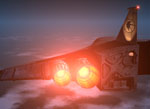 "The render at the right shows the Armstrong at its cruising altitude and gives us a good view of the back detailing. The ship was basically built from one perspective drawing and the details added later. The production time frame wa "The render at the right shows the Armstrong at its cruising altitude and gives us a good view of the back detailing. The ship was basically built from one perspective drawing and the details added later. The production time frame wa s very tight and we were designing the models at the same time whey were building the outside of the back of the ship for the exteriors that were filmed on-location. This caused some interesting back-and-forth about the detailing, which of course had to match. We went out to California to check out the location, but they didn't have the set built yet, so we wound working off technical drawings from the production designer and matching dailies. The render on the left shows the Armstrong shortly after takeoff. The wispy, drifting clouds were done entirely with fractal noise." s very tight and we were designing the models at the same time whey were building the outside of the back of the ship for the exteriors that were filmed on-location. This caused some interesting back-and-forth about the detailing, which of course had to match. We went out to California to check out the location, but they didn't have the set built yet, so we wound working off technical drawings from the production designer and matching dailies. The render on the left shows the Armstrong shortly after takeoff. The wispy, drifting clouds were done entirely with fractal noise."
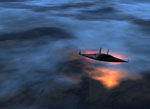 "We studied a natural phenomenon to make this scene realistic," says Pat. "They usually don't launch the Space Shuttle when there is cloud cover because it is impossible to visually track the craft, especially if anything goes wrong. Plus, the possibility for turbulence is much higher and the cloud moisture can cause problems with the booster rockets. However, every now and again there is a very thin layer to go through and when that happens, there is a really eerie and fabulous flash reflection in the clouds from the engines as the shuttle passes through. Because the film's producers wanted their craft (The Armstrong) to echo a 'new generation surplus Space Shuttle,' we emulated the effect the Shuttle makes when it passes through the clouds. The subtle movement of the clouds as the Armstrong passes through them makes the scene come alive." "We studied a natural phenomenon to make this scene realistic," says Pat. "They usually don't launch the Space Shuttle when there is cloud cover because it is impossible to visually track the craft, especially if anything goes wrong. Plus, the possibility for turbulence is much higher and the cloud moisture can cause problems with the booster rockets. However, every now and again there is a very thin layer to go through and when that happens, there is a really eerie and fabulous flash reflection in the clouds from the engines as the shuttle passes through. Because the film's producers wanted their craft (The Armstrong) to echo a 'new generation surplus Space Shuttle,' we emulated the effect the Shuttle makes when it passes through the clouds. The subtle movement of the clouds as the Armstrong passes through them makes the scene come alive."
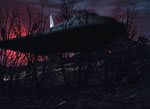 |
"The foreground of the scene on the left was developed from a photograph that we took while on-location in California where the exteriors were being shot. Similarly, the canyon in the picture on the right is also from an on-location photograph. We scanned them in at hi-res and then touched them up and enhanced them in Photoshop. There were some roads that needed to be removed, as well as some trucks in the canyon that had to go. |
 |
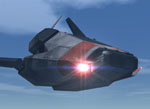 "I should set this one up a bit. In the film there's a point where the crew has to make use of one of the Armstrong's escape shuttles. The challenge here was to design a shuttle that could fit inside the Armstrong's interior, which had "I should set this one up a bit. In the film there's a point where the crew has to make use of one of the Armstrong's escape shuttles. The challenge here was to design a shuttle that could fit inside the Armstrong's interior, which had 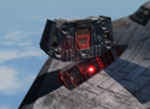 already been built on a soundstage. We only had so much room in the compartment and it was basically a square. We came up with the idea to blow off a door because the space was so tight inside and the shape of the Armstrong so sleek. If that wasn't enough, we also had to make the shuttle's exterior form match the interior which had also already been built. We had one set of demands on the exterior shape of the shuttle from the interior dimension of the Armstrong and another set of demands on the exterior based on the interior layout of the shuttle itself. The trick was to balance these in a compact shape. The folding wings idea really helped make that happen." Pat picks up, "Working things like that out really points up how organized and clear we have to be with the producers of the film, especially given the fact that our physical locations are far apart. There was a lot of phone time, a lot of fax paper on the floor, and many videotapes of test renders that passed back and forth to make the stunning CGI in this film a reality." already been built on a soundstage. We only had so much room in the compartment and it was basically a square. We came up with the idea to blow off a door because the space was so tight inside and the shape of the Armstrong so sleek. If that wasn't enough, we also had to make the shuttle's exterior form match the interior which had also already been built. We had one set of demands on the exterior shape of the shuttle from the interior dimension of the Armstrong and another set of demands on the exterior based on the interior layout of the shuttle itself. The trick was to balance these in a compact shape. The folding wings idea really helped make that happen." Pat picks up, "Working things like that out really points up how organized and clear we have to be with the producers of the film, especially given the fact that our physical locations are far apart. There was a lot of phone time, a lot of fax paper on the floor, and many videotapes of test renders that passed back and forth to make the stunning CGI in this film a reality."
On the Set
For Director of Photography Adam Kane, filming "Ravager" in and around Los Angeles was something to be reckoned with. Kane entered the project with a full understanding that director James Deck's style revolved around moving camera shots.
"Jim and I talked for a long time about how we could do some of the shots he wanted," Kane recalls. "We agreed that the only possible way to achieve them was to build a huge, practical working set of the Armstrong on a sound stage. Although the construction of such a set is a process usually reserved for productions with mega-buck budgets, producers Isaacs, McGinnis and Patrick also recognized the film's visual needs.
"The costs were daunting," states Isaacs. "But we knew going in they would be. The ship constitutes the film's main set, perhaps 75-percent of the picture. It was an absolute necessity. Besides, my partners and I don't believe in skimping when it comes to a picture's 'look.' The creation of great visual reality is what filmmaking's all about. We also believe in giving our picture-makers what they feel they need to make the picture work."
Accordingly, the entire schematic layout of the sub-orbital transport was designed and painstakingly constructed under the supervision of Production Designer Ron Mason and Art Director Rich Thomas in such a way that the actors and crew could move through the entire ship without interrupting camera movement. The result is an extraordinary interior set, one which fully satisfied director Deck's penchant for moving shots -- and one in which the filmmakers, cast and crew remain justifiably proud.
Although the story mainly takes place in a desolate hellhole crash-landing site on earth, the need to establish Armstrong's liftoff, the craft's malfunction, and its descent to earth under emergency conditions, provide to be another significant challenge.
"Just a few years ago such shots would have pushed the budget in to a realm that would have made the production impossible," states producer Isaacs. "But now, thanks to advancements in computer generated imaging, it's just very expensive."
360 entertainment turned to New Jersey-based Corbitt Design, a company headed by Pat Corbitt which has been on the vanguard of designing computer graphics from the beginning. "Pat did some remarkable shots for us on 'Within the Rock,'" Isaacs states. "We knew if anyone could give us what we needed for 'Ravager,' it was Corbitt Design."
Corbitt Design has, in fact, been doing computer generated graphics (CGI) for 30 years. "In the beginning," Pat Corbitt explains, "we opted to stay in television because the image is smaller, thus requiring less resolution than film. At that time, big-screen imaging required faster, far more expensive machines to render the required designs. It was just too costly. Advancements in computer technology and equipment now allow us to do imaging faster, better and at a fraction of the cost of what it was even a few years ago." |
 |



